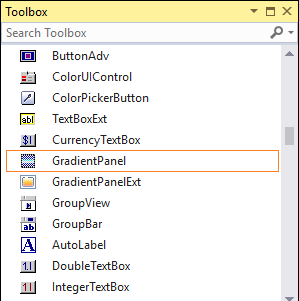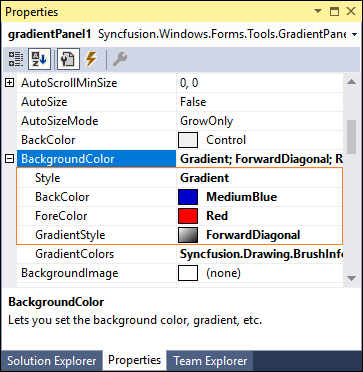Getting Started with Windows Forms Gradient Panel
11 Oct 20225 minutes to read
This section will guide you to create a Gradient Panel via designer and also programming approach.
Assembly deployment
Refer to the Control Dependencies section to get the list of assemblies or details of NuGet package that needs to be added as a reference to use the control in any application.
Click NuGet Packages to learn how to install nuget packages in a Windows Forms application.
Adding GradientPanel control via designer
-
Create a new Windows Forms application in Visual Studio.
-
The GradientPanel control can be added to an application by dragging it from the toolbox to a designer view. The following dependent assembly will be added automatically:
- Syncfusion.Shared.Base

- Set background color to GradientPanel through property grid.

Adding GradientPanel control via code
The following steps guide you how to create a gradient panel programmatically.
-
Create a C# or VB application via Visual Studio.
-
Add the following assembly reference to the project:
- Syncfusion.Shared.Base
-
Include the required namespace.
using Syncfusion.Windows.Forms.Tools;Imports Syncfusion.Windows.Forms.Tools -
Create an instance of GradientPanel control, and add it to the form.
private Syncfusion.Windows.Forms.Tools.GradientPanel gradientPanel1; this.gradientPanel1 = new Syncfusion.Windows.Forms.Tools.GradientPanel(); this.Controls.Add(this.gradientPanel1);Friend WithEvents GradientPanel1 As Syncfusion.Windows.Forms.Tools.GradientPanel Me.gradientPanel1 = New Syncfusion.Windows.Forms.Tools.GradientPanel() Me.Controls.Add(Me.gradientPanel1)
Styles
The GradientPanel control provides different set of background styles. The styles are Solid, Pattern, and Gradient.
Solid
this.gradientPanel1.BackgroundColor = new Syncfusion.Drawing.BrushInfo(System.Drawing.Color.MediumBlue);
this.gradientPanel1.BorderColor = System.Drawing.Color.Red;
this.gradientPanel1.BorderStyle = System.Windows.Forms.BorderStyle.FixedSingle;Me.gradientPanel1.BackgroundColor = New Syncfusion.Drawing.BrushInfo(System.Drawing.Color.MediumBlue)
Me.gradientPanel1.BorderColor = System.Drawing.Color.Red
Me.gradientPanel1.BorderStyle = System.Windows.Forms.BorderStyle.FixedSingle
Pattern
this.gradientPanel1.BackgroundColor = new Syncfusion.Drawing.BrushInfo(Syncfusion.Drawing.PatternStyle.LargeCheckerBoard, System.Drawing.Color.Turquoise, System.Drawing.Color.MediumBlue);
this.gradientPanel1.BorderColor = System.Drawing.Color.PaleTurquoise;
this.gradientPanel1.BorderStyle = System.Windows.Forms.BorderStyle.FixedSingle;Me.gradientPanel1.BackgroundColor = New Syncfusion.Drawing.BrushInfo(Syncfusion.Drawing.PatternStyle.LargeCheckerBoard, System.Drawing.Color.Turquoise, System.Drawing.Color.MediumBlue)
Me.gradientPanel1.BorderColor = System.Drawing.Color.PaleTurquoise
Me.gradientPanel1.BorderStyle = System.Windows.Forms.BorderStyle.FixedSingle
Gradient
this.gradientPanel1.BackgroundColor = new Syncfusion.Drawing.BrushInfo(Syncfusion.Drawing.GradientStyle.ForwardDiagonal, System.Drawing.Color.Red, System.Drawing.Color.MediumBlue);
this.gradientPanel1.BorderColor = System.Drawing.Color.Transparent;
this.gradientPanel1.BorderStyle = System.Windows.Forms.BorderStyle.FixedSingle;Me.gradientPanel1.BackgroundColor = New Syncfusion.Drawing.BrushInfo(Syncfusion.Drawing.GradientStyle.ForwardDiagonal, System.Drawing.Color.Red, System.Drawing.Color.MediumBlue)
Me.gradientPanel1.BorderColor = System.Drawing.Color.Transparent
Me.gradientPanel1.BorderStyle = System.Windows.Forms.BorderStyle.FixedSingle